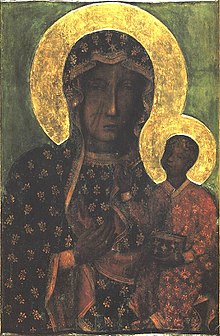Ezili Dantor

Èzili Dantò or Erzulie Dantor is the main
Worship
Tuesdays are the days reserved to worship Ezili Dantor. Worship is normally done in solitary in front of an altar identified by the colors blue, black and red. The most recurrent sacrifices consist of crème de cacao, jewels, golden rings and Agua de Florida. For her birthday a wild pig is normally the main sacrifice. [citation needed]
Haitian Mythology
In Haitian mythology, there are multiple spiritual entities, or lwa, that work between the mortal world and the divine world. Ezili are feminine spirits that personify different aspects of womanhood. Ezili Freda is a Rada Loa who represents romantic love and erotic sexuality, while Ezili Dantor is Petro and represents the hardworking and sometimes angry mother,[1] although she is also known to take on lovers of her own.[3] Ezili Dantor is believed to have children of her own in some stories, such as Ti-Jean Petwo, and is a fervid protector of the youth and the marginalized.[4]
Ezilí Freda is Dantor's rival and is said to be responsible for leaving scars on Dantor's cheek -known as twa màk[3]- during a fight over the love of Ogou, according to some legends.[5] Another distinction between them is that Freda is light-skinned and relatively wealthy, indicative of her status as an upper-class woman.[3] Thus, Ezili Dantor strongly resonates with lower class women in Haitian society.[6]
Other stories in the religion note that Èzili Dantò is nonspeaking as a result of her tongue being cut out by other Haitian Revolutionaries who feared she would betray them.[4] Èzili Dantò only utters syllables during possession because of this, and is capable of becoming extremely angry and vengeful, to the point that she is considered evil, though she is not inherently so. [3]
Dantor's anger has the power to destroy, and her vehement displeasure has earned her the reputation of being the red eyed, "Èzili je wouj". Her destructive powers often come in the form of natural disasters and the forces of nature. Her rage is even said to be able to afflict those who anger her with extremely painful illnesses.[7] In Zora Neale Hurston’s Haiti and Their Eyes Were Watching God, Ezili's Danto's rage is described as "violent reminder to the folk that their passive faith in Euro-Americans, or Christianity, to determine their fate is misguided."[1]
Ultimately, Ezili Dantor "rages and destroys, but she also suffers", known to be associated with fertility problems women experience, including aphasia. However, at heart, Ezili Dantor is a devoted and selfless mother, willing to do all that is possible to protect those she loves and cares for, even "turn the world upside down". Those who venerate Dantor are expected to serve her with the same undying loyalty in return, as well as caution.[4]
Ezili Dantor and the Haitian Revolution

It is accounted that the slave revolt of 1791, started with a pact which followed a big feast in honour to Ezili Dantor. For this reason she is considered the national Lwa. Considered to be a fearless warrior in the Petro Nation (Petwo Nanchon in Haitian Creole), Dantor has been popular among single mothers during the 1980s and 1990s in Haiti and Dominican Republic.
Syncretic modern representations of Dantor sometimes associate her with the Mater Salvatoris,[4] especially those depicted with children; Our Lady of Lourdes and Our Lady of Mount Carmel as examples.[3] The most common association however, is the Black Madonna of Częstochowa,[8][9] the patron saint of Poland.
The original association of Ezili Dantor with the Black Madonna of Częstochowa is hypothesized to be from copies of the icon brought to Haiti by Polish soldiers sent by order of
References in popular culture
Books
- The 2013 novel Zora Neale Hurston, Haiti, and Their Eyes Were Watching God is a collection of ten (10) essays from various authors that break down and analyze the literary work of Zora Neale Hurston, and her 1937 novel Their Eyes Were Watching God. Hurston's stories follow a light-skinned woman by the name of Janie Crawford. Hurston writes the character of Janie with characteristics that resemble Ezili Freda, but that both Freda and Danto live within her. Janie falls in love with and marries a dark-skinned man named Tea Cake but must show him that she is not above working in the fields like other working-class folk. By working in the fields, Janie shows that she is not afraid of hard work, is mature, and embraces Ezili Danto. [1]
- In the Mambo Reina Series by Veronica G. Henry, the main character is a Mamba who is dedicated to Erzulie.[12]
Music
- Paul Beaubrun performed a song dedicated to Ezili on his album Ayibobo.[13]
- "Ezili" - (from the album "Potomitan") is a song written by Sélène Saint-Aimé a French-Caribbean contrabass player, vocalist and poet.
See also
References
- ^ ISBN 9780810166585.
- ^ Dayan, Joan (1994). "Erzulie: A women's history of Haiti". Research in African Literatures. 25 (2).
- ^ a b c d e
Brown, Karen McCarthy (2001). Mama Lola, a Vodou Priestess in New York. Berkeley: University of California Press. p. 225-248. ISBN 9780520224759.
- ^ a b c d Braziel, Jana Evans (2016). "ATIS REZISTANS (RESISTANCE ARTISTS): Vodou Street Sculpture at the Grand Rue, Port-Au-Prince."". Callaloo. 39 (2): 419–437. Retrieved 21 May 2023.
- ^ Llerena Cano, Guillermo. The Petro and the Rada. January 2011.
- JSTOR 41711916– via JSTOR.
- ^ Desmangles, Leslie Gerald. The Faces of the Gods: Vodou and Roman Catholicism in Haiti. Chapel Hill, NC: University of North Carolina P, pg 133, 1992.
- ISBN 978-0-19-514890-9.
- ^ Krista, White (1999–2000). "Espousing Ezili: Images of a Lwa, Reflections of the Haitian Woman". Journal of Haitian Studies. 5/6. Center for Black Studies Research: 68.
- ISBN 9781468301601. Retrieved 1 January 2015.
- ^ "Re Polish presence in Haiti: Judson comments" Archived 2008-03-25 at the Wayback Machine—Discussion on webster.edu.
- ^ "Mambo Reina". www.amazon.com. Retrieved 2023-03-18.
- ^ Paul Beaubrun. "Ezili". Ayibobo, Ropeadope LLC, 2018.
